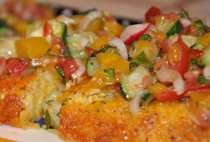I’m always thrilled to see the progress of the tomatoes and blueberries and everything else in the garden. But this week I am positively excited – maybe over-excited – by the corn.
I’ve always wanted to have that farmer’s experience of don’t pick the corn until the water’s boiling. To cook and eat it before a molecule of sugar converts to starch.
But I never really thought I could grow corn in a container in the city. I decided to give it a try when I saw them doing it at the NY Botanical Garden for last year’s Edible Garden exhibit. Even then, I thought I might get some corn stalks, but no corn – more of an urban sight gag than an edible crop.
But now … it looks like my stalks are growing corn! I could let nature continue to take its course, but I decided to try to help things along in a very hands-on way. So if you always wanted to know but were afraid to ask: watch the video to see how corn makes babies.
The long, thin thing at the top of the plant is the tassel. As you may have guessed, it’s the male organ – over the course of a few days, it releases more than 10 million grains of pollen.
The female organs, of course, are hidden away and protected. They’re actually tiny flowers that cover what we know as the corn cob, and they’re carefully wrapped up in the husk. Each one is attached to a sticky strand of corn silk.
So, how do we get from the tassel up there to the silk down there? The answer, my friend, is blowin in the wind. When a pollen grain gets blown off the tassel and lands at the tip of a silk strand, it gets transported down along the silk to the flower. That’s pollination – and the little flower’s on its way to becoming a corn kernel.
The plant makes more than 20,000 pollen grains for each silk thread, so odds are pretty good that this’ll turn into an ear of corn and not a barren cob. But I’m not taking any chances. This is the ultimate test of my green thumb, so I’ll admit to having a little performance anxiety before I, uh, did what I did in the video. I’ll let you know in August how it all turns out.
Corn provides high quality dietary fiber. No matter how sugar-sweet it tastes, you’ll digest this low glycemic index whole grain very slowly, so it helps maintain stable glucose levels.
Corn can provide complete protein from vegetable sources. Eat it with fava, lima, pinto or other beans and get high quality protein. The beans have all but one of the essential amino acids, methionine – the one amino acid that corn has lots of.
Polenta cake with tomatoes, corn, cucumbers, peppers.

